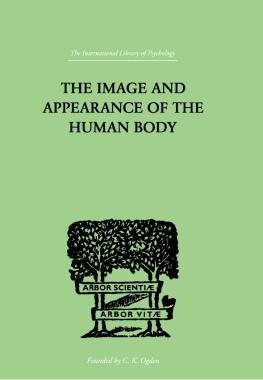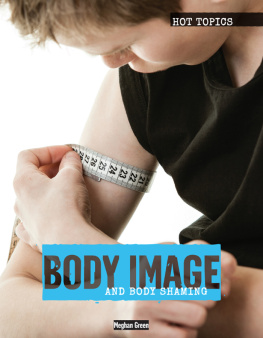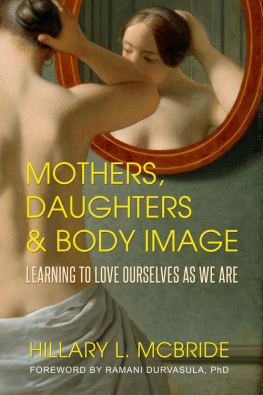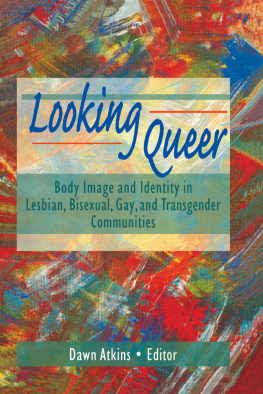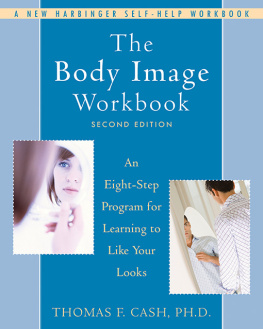Schilder - The Image and Appearance of the Human Body
Here you can read online Schilder - The Image and Appearance of the Human Body full text of the book (entire story) in english for free. Download pdf and epub, get meaning, cover and reviews about this ebook. year: 2013,1999, publisher: Taylor and Francis, genre: Detective and thriller. Description of the work, (preface) as well as reviews are available. Best literature library LitArk.com created for fans of good reading and offers a wide selection of genres:
Romance novel
Science fiction
Adventure
Detective
Science
History
Home and family
Prose
Art
Politics
Computer
Non-fiction
Religion
Business
Children
Humor
Choose a favorite category and find really read worthwhile books. Enjoy immersion in the world of imagination, feel the emotions of the characters or learn something new for yourself, make an fascinating discovery.
- Book:The Image and Appearance of the Human Body
- Author:
- Publisher:Taylor and Francis
- Genre:
- Year:2013,1999
- Rating:4 / 5
- Favourites:Add to favourites
- Your mark:
- 80
- 1
- 2
- 3
- 4
- 5
The Image and Appearance of the Human Body: summary, description and annotation
We offer to read an annotation, description, summary or preface (depends on what the author of the book "The Image and Appearance of the Human Body" wrote himself). If you haven't found the necessary information about the book — write in the comments, we will try to find it.
Schilder: author's other books
Who wrote The Image and Appearance of the Human Body? Find out the surname, the name of the author of the book and a list of all author's works by series.
The Image and Appearance of the Human Body — read online for free the complete book (whole text) full work
Below is the text of the book, divided by pages. System saving the place of the last page read, allows you to conveniently read the book "The Image and Appearance of the Human Body" online for free, without having to search again every time where you left off. Put a bookmark, and you can go to the page where you finished reading at any time.
Font size:
Interval:
Bookmark:
CASE HISTORIES OF ORGANIC BRAIN LESIONS
(a) Polyaesthesia and transfer of sensations from the left to the right side of the body in a case of parietal and capsula lesion
Barbara M., born 1880, in the neurological clinic of the University of Vienna, from December 10th, 1922, to March 23rd, 1923. Family history and previous history without importance. Lues 1911. Apoplectic insult on February 7th, 1931. On February 10th, according to the report of another hospital, hemiparesis on the right side, analgesia, and anaesthesia on the right side of the body. Right angle of the mouth drops, tongue deviates to the right side and can be moved to the left side only with difficulty. The patient is unable to look to the right. The eyes go to the left and upward. Pupils are narrow and fixed to light. Babinski, Oppenheim, Gordon plus on the right side. Patellar and Achilles tendon reflexes absent. Speech slurred. Patient is somnolent and yawns often. Inner organs normal. Wassermann negative. On February 11th, slight degree of stiffness of the neck. February 19th, spasms of the right lower extremities. February 28th, strong perspiration of right arm. March 1st, head turned to the right side. March 3rd, sensibility for pain and touch is improving. April 9th, hemiplegia improved, patellar and Achilles tendon reflexes are stronger on the right side than on the left. Sensibility almost normal.
In the meantime the patient had several treatments. My findings are based upon a series of examinations. A change occurred only towards the end of the long observation. Inner organs and bones are normal. Wassermann in blood and spinal fluid positive. Nonne-Apelt positive. Two lymphocytes. Neurologically; paresis of the lower facial on the right side; the protruded tongue deviates to the right; palate and swallowing normal; speech normal; ocular movements free; no nystagmus; the pupils react
These case histories will have interest for neurologists.
sluggishly to light, but well to accommodation; corneal, conjunctival, palate reflexes normal; visual field, eye grounds, hearing, vestibular apparatus, smell and taste normal; the right shoulder droops. There is a severe paresis of predilection type. On the right arm, typical posture. But the spasms are very limited, although of pyramidal character. The range of movements is diminished in all joints. It it best in the shoulder, whereas a voluntary movement of the hand is impossible. The tendon and periostal reflexes of the arm are stronger on the right than on the left side. Examination of co-ordination and diadochokinesis impossible. Paresis of the muscles of the trunk. Abdominals present on both sides. The right leg shows a strong pronation of the foot. Otherwise there is paresis of the predilection type of medium degree (only the motility of the toes is diminished). The tone shows a very mild tension of pyramidal character, the foot is even hypotonic. No ataxia, no adiadochokinesis. Patellar and Achilles tendon reflexes stronger on the right than on the leftside. Ankle clonus on the right side. Babinski, Oppenheim, Rossolimo plus on the right side. When the patient tries to walk, her shoulder sinks forward and she is unable to walk even with the help of sticks. Bladder and rectum functions are normal.
The sensibility shows the following disturbances. There is spontaneous pain in the region of the right eye. The pain sometimes diminishes to paraesthesias, sometimes it is completely absent. Sense of posture; she gives prompt answers concerning the left side of her body. If one lets her imitate passive movements of the right side of her body with the left side, she makes almost grotesque mistakes. If one examines, in the common way, the perception of the direction of the passive movements, the disturbance is greatest in hand and foot, whereas the disturbance is much less in the proximal joints. Sometimes one has the impression that the patient perceives in hand and foot when a movement has taken place, but that she is not clear about the direction of the movement.
She hallucirates often and believes that movements with her fingers have been made even if no examination has been started. Passive movements which have been made on the joints of the left extremities often provoke, after from 4 to 10 seconds, fainter sensations of the same character in the right extremities.
Generally, the sensibility of the patient on the right side of the body is characterized in the following way; there is a marked disposition to hallucinations on the right side of the body, and sensations on the left side of the body provoke, a short time later (from 4 to 10 seconds), an analogous sensation on a symmetrical spot on the right side of the body.
Temperature perception; sensation for cold is intact, sensation for heat has disappeared on the right side.
Pain of the deeper parts and on the surface is preserved. The patient is less sensitive to the faradic brush on the right side. Itching is identical on both sides of the body. Tickling is mostly felt as a touch on the right side. Pallaesthesia and sensitiveness to deep pressure are identical on both sides. Weights are felt on both sides in the same way. Touch is localized on the right side in a grotesquely wrong way. The gentlest touches are felt correctly. When the patient is touched on the right side, near the breast, she feels it first on the shoulder, but after from 4 to 10 seconds later she has a second sensation near the elbow, a third on the upper part of the leg, and a fourth on the dorsal side of the foot. But the sensations, 2, 3, and 4 are duller and less distinct than the first sensation. This polyaesthesia is constant when the right side of the body is touched. But fairly often only two sensations are felt. The polyaesthesia is also present when the stimulus is applied to the left side. At first, on the symmetrical spot of the right side, weaker and fainter sensations appear, and, after that, another one more distally localized. The right sensation is not always absolutely symmetrical to the left one. A touch on the left hand may provoke a sensation at the same level on the trunk.
The same phenomena are present when pin-pricks are applied. A pin-prick in the right upper leg provokes an indistinctly localized pin-prick sensation which is followed by a sensation of touch. If one pricks the left upper leg, a duller pin-prick appears on an approximately symmetrical place on the right upper leg. Although the localization for pin-pricks and touch on the right side is generally poor, the patient occasionally gives correct answers. A pin-prick in the right big toe can be occasionally localized correctly. The mistakes differ in direction and size. Sometimes they are only a few centimetres, but sometimes a touch on the trunk may be transferred to the foot or the face, in transversal direction. The mistakes increase with fatigue. When she has paraesthesias in the face, she localizes all touches in the face. Also the left-sided temperature sensations are generally transferred without qualitative changes to the right side of the body. A touch with a warm glass is felt first on the left, then on the right side, although a little less warm, and for the most part approximately symmetrical. The same is true about sensations of cold and of pallaesthesia. Even when objects are put into her left hand, she feels them in her right hand also. Sometimes a sensation of cold and heat on the left side provokes only a pressure sensation on the right side. A touch of the nipple on the right side is generally well localized. When the patients right arm is touched with rough clothes or with a brush, she feels only a simple touch or a pin-prick, even when the touch is spread over a large area, and when extensive movements are made on the skin. Lines on the skin made with the finger are felt only as a touch, even if the line is as long as 20 centimetres. Sometimes it is felt as several touches. If the nipples are touched, the patient localizes the touch on the nipple. Sometimes the patient pretended to feel the movement as a downward movement when the line was drawn by an upward movement. When a movement on the skin was made, the patient very often stated that her finger joints were moved. It is also true that all sensible qualities are transferred from the left side to the right side and that they are polyaesthetic. The second sensation is always a sensation of touch when there has been a sensation on the right side.
Next pageFont size:
Interval:
Bookmark:
Similar books «The Image and Appearance of the Human Body»
Look at similar books to The Image and Appearance of the Human Body. We have selected literature similar in name and meaning in the hope of providing readers with more options to find new, interesting, not yet read works.
Discussion, reviews of the book The Image and Appearance of the Human Body and just readers' own opinions. Leave your comments, write what you think about the work, its meaning or the main characters. Specify what exactly you liked and what you didn't like, and why you think so.

